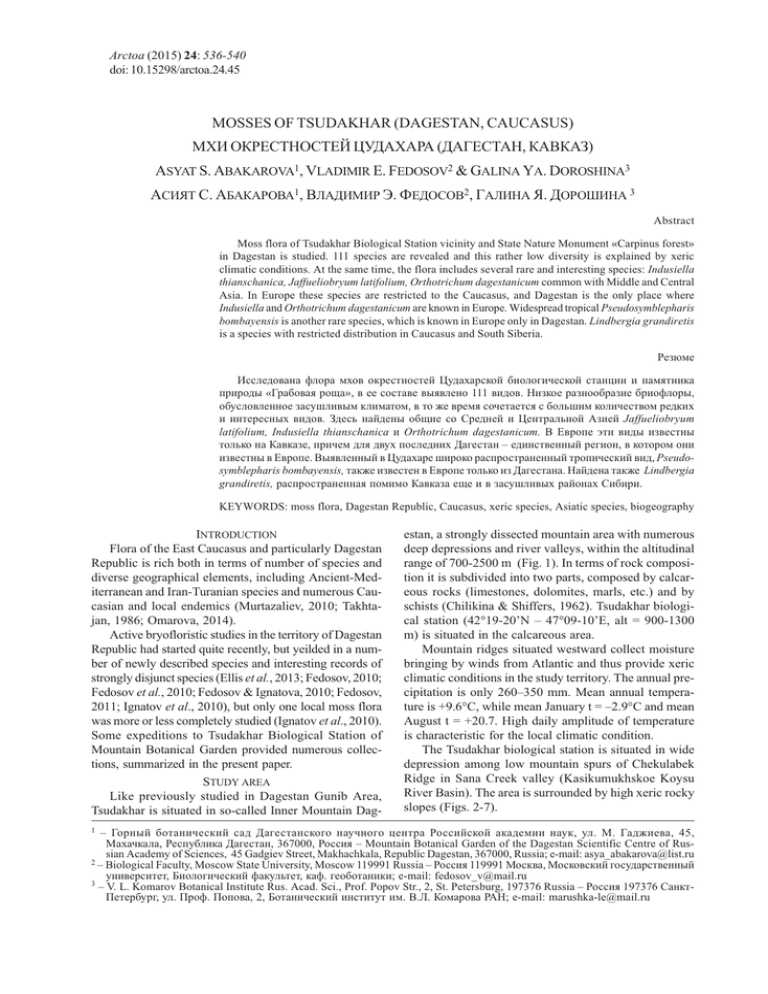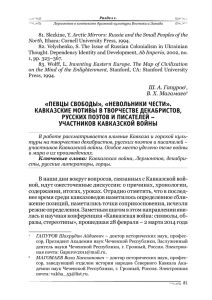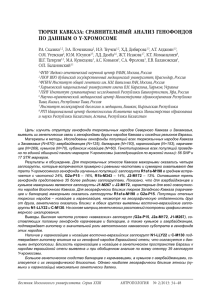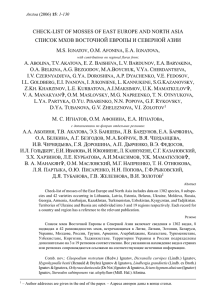MOSSES OF TSUDAKHAR (DAGESTAN, CAUCASUS) МХИ
реклама

Arctoa (2015) 24: 536-540 doi: 10.15298/arctoa.24.45 MOSSES OF TSUDAKHAR (DAGESTAN, CAUCASUS) МХИ ОКРЕСТНОСТЕЙ ЦУДАХАРА (ДАГЕСТАН, КАВКАЗ) АSYAT S. ABAKAROVA1, VLADIMIR E. FEDOSOV2 & GALINA YA. DOROSHINA3 АСИЯТ С. АБАКАРОВА1, ВЛАДИМИР Э. ФЕДОСОВ2, ГАЛИНА Я. ДОРОШИНА 3 Abstract Moss flora of Tsudakhar Biological Station vicinity and State Nature Monument «Carpinus forest» in Dagestan is studied. 111 species are revealed and this rather low diversity is explained by xeric climatic conditions. At the same time, the flora includes several rare and interesting species: Indusiella thianschanica, Jaffueliobryum latifolium, Orthotrichum dagestanicum common with Middle and Central Asia. In Europe these species are restricted to the Caucasus, and Dagestan is the only place where Indusiella and Orthotrichum dagestanicum are known in Europe. Widespread tropical Pseudosymblepharis bombayensis is another rare species, which is known in Europe only in Dagestan. Lindbergia grandiretis is a species with restricted distribution in Caucasus and South Siberia. Резюме Исследована флора мхов окрестностей Цудахарской биологической станции и памятника природы «Грабовая роща», в ее составе выявлено 111 видов. Низкое разнообразие бриофлоры, обусловленное засушливым климатом, в то же время сочетается с большим количеством редких и интересных видов. Здесь найдены общие со Средней и Центральной Азией Jaffueliobryum latifolium, Indusiella thianschanica и Orthotrichum dagestanicum. В Европе эти виды известны только на Кавказе, причем для двух последних Дагестан – единственный регион, в котором они известны в Европе. Выявленный в Цудахаре широко распространенный тропический вид, Pseudosymblepharis bombayensis, также известен в Европе только из Дагестана. Найдена также Lindbergia grandiretis, распространенная помимо Кавказа еще и в засушливых районах Сибири. KEYWORDS: moss flora, Dagestan Republic, Caucasus, xeric species, Asiatic species, biogeography INTRODUCTION Flora of the East Caucasus and particularly Dagestan Republic is rich both in terms of number of species and diverse geographical elements, including Ancient-Mediterranean and Iran-Turanian species and numerous Caucasian and local endemics (Murtazaliev, 2010; Takhtajan, 1986; Omarova, 2014). Active bryofloristic studies in the territory of Dagestan Republic had started quite recently, but yeilded in a number of newly described species and interesting records of strongly disjunct species (Ellis et al., 2013; Fedosov, 2010; Fedosov et al., 2010; Fedosov & Ignatova, 2010; Fedosov, 2011; Ignatov et al., 2010), but only one local moss flora was more or less completely studied (Ignatov et al., 2010). Some expeditions to Tsudakhar Biological Station of Mountain Botanical Garden provided numerous collections, summarized in the present paper. STUDY AREA Like previously studied in Dagestan Gunib Area, Tsudakhar is situated in so-called Inner Mountain Dag1 estan, a strongly dissected mountain area with numerous deep depressions and river valleys, within the altitudinal range of 700-2500 m (Fig. 1). In terms of rock composition it is subdivided into two parts, composed by calcareous rocks (limestones, dolomites, marls, etc.) and by schists (Chilikina & Shiffers, 1962). Tsudakhar biological station (42°19-20’N – 47°09-10’E, alt = 900-1300 m) is situated in the calcareous area. Mountain ridges situated westward collect moisture bringing by winds from Atlantic and thus provide xeric climatic conditions in the study territory. The annual precipitation is only 260–350 mm. Mean annual temperature is +9.6°C, while mean January t = –2.9°C and mean August t = +20.7. High daily amplitude of temperature is characteristic for the local climatic condition. The Tsudakhar biological station is situated in wide depression among low mountain spurs of Chekulabek Ridge in Sana Creek valley (Kasikumukhskoe Koysu River Basin). The area is surrounded by high xeric rocky slopes (Figs. 2-7). – Горный ботанический сад Дагестанского научного центра Российской академии наук, ул. М. Гаджиева, 45, Махачкала, Республика Дагестан, 367000, Россия – Mountain Botanical Garden of the Dagestan Scientific Centre of Russian Academy of Sciences, 45 Gadgiev Street, Makhachkala, Republic Dagestan, 367000, Russia; e-mail: [email protected] 2 – Biological Faculty, Moscow State University, Moscow 119991 Russia – Россия 119991 Москва, Московский государственный университет, Биологический факультет, каф. геоботаники; e-mail: [email protected] 3 – V. L. Komarov Botanical Institute Rus. Acad. Sci., Prof. Popov Str., 2, St. Petersburg, 197376 Russia – Россия 197376 СанктПетербург, ул. Проф. Попова, 2, Ботанический институт им. В.Л. Комарова РАН; e-mail: [email protected] Mosses of Tsudakhar (Dagestan, Caucasus) 537 C Fig. 1. Study area. Table 1. Species list: C – Carpinus wood, open slopes. C Abietinella abietina + Aloina rigida Amblystegium serpens + Anoectangium handelii Anomodon viticulosus + Barbula convoluta B. unguiculata + Brachythecium campestre + B. cirrosum B. mildeanum B. salebrosum + Bryoerythrophyllum recurvirostrum Bryum argenteum + B. caespiticium B. moravicum + Calliergonella lindbergii Campyliadelphus chrysophyllus + Campylidium calcareum + Ceratodon purpureus + Cratoneuron filicinum Crossidium squamigerum Dicranum dispersum + Didymodon rigidulus D. validus + Distichium capillaceum + Ditrichum flexicaule Encalypta pilifera E. procera + E. trachymitria Entodon concinnus + E. schleicheri Entosthodon muhlenbergii Fissidens bryoides + F. dubius + F. exiguus Funaria hygrometrica + Grimmia anodon G. laevigata G. pulvinata G. tergestina Gymnostomum aeruginosum G. calcareum N- and S-facing N + + + + + S + + + + + + + + + + + + + + + + + + + + + + + + + + + + + + Homalothecium sericeum Homomallium incurvatum Hypnum cupressiforme Indusiella thianschanica Jaffueliobryum latifolium Leucodon immersus L. sciuroides Lindbergia gradiretis Microbryum curvicollus Mnium lycopodioides M. stellare Molendoa scliephackei M. sendtneriana Myurella sibirica Neckera besseri Orthotrichum affine O. anomalum O. dagestanicum O. diaphanum O. obtusifolium O. pallens O. pumilum O. sordidum O. speciosum O. stramineum O. striatum Oxyrrhynchium hians Plagiomnium rostratum P. undulatum Pseudoleskeella catenulata P. nervosa P. tectorum Pseudosymblepharis bombayensis Pterygoneurum ovatum P. subsessile Pylaisia polyantha Rhodobryum ontariense Rhytidium rugosum Schistidium apocarpum S. crassipilum S. helveticum S. robustum Seligeria pusilla Stereodon vaucheri Syntrichia ruralis S. sinensis Taxiphyllum wissgrillii Thuidium assimile Timmia bavarica Tortella inclinata T. tortuosa Tortula acaulon T. atrovirens T. inermis T. lanceola T. modica T. mucronifolia T. muralis T. protobryoides Trachycystis ussuriensis Trichostomum brachydontium T. crispulum Weissia brachycarpa W. controversa W. levieri W. longifolia W. rostellata + N + + + S + + + + + + + + + + + + + + + + + + + + + + + + + + + + + + + + + + + + + + + + + + + + + + + + + + + + + + + + + + + + + + + + + + + + + + + + + + + + + + 538 А.S. ABAKAROVA, V.E. FEDOSOV & G.YA. DOROSHINA 2 3 4 5 6 7 8 9 Figs. 2-9. Study area: 2-5: S-facing slope; 6:N-facing slope; 7: biostation in Sana Creek Valley; 8-9: Carpinus forest. Mosses of Tsudakhar (Dagestan, Caucasus) On dry south-facing slopes steppe communities occur, dominated with Botriochloa ischaemum, Salvia canescens, Onobrychys bobrovii, Stipa daghestanica, Allium albidum, Sedum oppositifolium, Sempervivum caucasicum, Carex huetiana, Artemisia daghestanica, A. galodendron, Helianthemum daghestanicum, Satureja subdentata, etc. (Murtazaliev, 2009; Murtazaliev & Guseynova, 2014). Steppe communities alternate with polydominant montane xerophyte shrubs where Rosa canina, R. spinosissima, Crataegus pseudoheterophylla, Berberis vulgaris, Spiraea hypericifolia, Artemisia salsoloides, A. marshalliana, Thymus daghestanicus, Onobrychis cornuta, Astragalus haesitabundus, A. alexandrii, A. onobrychioides, A. bungeanus, etc. are common. Steep north-facing slopes are covered by open petrophyte communities with Teucrium chamaedrys, T. polium, Salvia canescens, S. verticillata, Gypsophila tenuifolia, Onobrychys cornuta, Astragalus alexandrii, A. fissuralis, where also rare shrubs of Rosa canina and Juniperus oblonga occur (Asadulaev et al., 2013). Pastures with strong grazing pressure have communities of Cirsium spp., Euphorbia spp., Meniocus spp., Taraxacum spp. On sandy slopes, Iris timofejewii, a rare xerophytic species and endemic of the Dagestan, grows. The nature monument “Carpinus forest” (42°20’ N; 47°10’E) occurs on the northern and north-eastern slopes of Chekulabek Ridge with altitudinal range 1150-1300 m. This forest occupies an area of ca. 5 hectars. This is a Carpinus caucasica dominated forest with admixture of Tilia cordata and shrub layer composed of Euonymus verrucosus, Spiraea hypericifolia, Rosa pimpinellifolia and Cotoneaster meyeri, but in many places lacking any shrubs as well as herbs (Fig. 9). BRYOPHYTE EXPLORATION Since 2011 the territory was studied in the course of several short excursions by authors, once together with with M.S. Igantov and N.A. Konstantinova (in 2011). Totally ca. 500 specimens were studied, they are kept in MW, MHA and LE. List of species revealed in the vicinity of the Tsudakhar biological station is provided in table 1, where species presence is shown separately for Southfacing (Figs. 2-5), North-facing (Figs. 6-7) open slopes of Sana River valley and Carpinus forest (Figs. 8-9). Nomenclature follows Ignatov, Afonina, Ignatova et al. (2006). The list includes 111 species, which might be considered not so many for the mountain area with numerous rocky habitats. However considering small area studied and xeric climatic conditions this number seems to be rather close to its real diversity. The main interest of the flora is that despite of a low overall diversity it inlcudes many rare and phytogeographically noticable species. Two of them, Indusiella thianschanica and Lindbergia grandiretis, are included in Red Data Book of Russian Federation (Bardunov, 2008). In this publication the 539 latter species is named Lindbergia brachyptera, but recent revision has shown that the latter species does not occur in Russia and specimens referred to it have to be considered as Lindbergia grandiretis (Ignatova et al., 2010), previously considered as a synonym of L. brachyptera, but obviously is distinct by both morphology and molecular markers. Regardless this nomenclatural issue, it is a very rare species in the Caucasus, requiring protection. For Indusiella, Dagestan is the only region where it occurs not only for the Caucasus, and also for the whole Europe in definition given by Hill et al. (2006). In Central Asia, the area where Indusiella is common in deserts (Ignatov et al., 2004), it usually grows associated with Tortula atrovirens, Jaffueliobryum latifolium, Syn1 trichia submontana . In Europe two latter species occur only in the Caucasus. Jaffueliobryum also was found in Actoprac xeric depression in Kabardino-Balkaria (Kharzinov et al., 2006) and in Stavropol Territory (Doroshina, 2008). Orthotrichum dagestanicum, the species described only few years ago (Fedosov & Ignatova, 2010), also represents Asiatic relationships in the moss flora of Dagestan. An exploration of the Middle Asian moss flora by V. Plášek revealed that O. dagestanicum is rather common in Kyrgyzstan, in central Tian-Shan Mountains, i.e. 2500 km eastward from Dagestan (Ellis et al., 2015). Among species found in Tsudakhar there also is widespread tropical species, Pseudosymblepharis bombayensis, previously revealed in Gunib Plateau (Ignatova et al., 2012). It is another example of a speices known in Europe only in Dagestan. All these data indicate an outstanding phytogeographic boundary that separates Dagestan from the rest north Caucasus. This territory will obviously bring many new discoveries. ACKOWLEDGEMENTS We are greatly indebted to Z.M. Asadulaev for the assistance in field work organisation and to Michael Ignatov for data about his collections and correcting English of the paper. The work was partly supported by RFBR #14-04-01424. LITERATURE CITED AFONINA, O.M., E.A. IGNATOVA, V.E. FEDOSOV & O.I. KUZNETSOVA. 2014. Toward a new understanding of Syntrichia submontana. – Arctoa 23: 11–24. ASADULAEV, Z.M., M.M. MALLALIEV & G.A. SADYKOVA] АСАДУЛАЕВ З.М., М.М. МАЛЛАЛИЕВ, Г.А. САДЫКОВА. 2013. Флористические и структурные особенности пионерных и демутационных сообществ нарушенных известняковых склонов Дагестана. – [Floristic and structural features of the pioneer communities and demutation broken limestone slopes of Dagestan] Вестник Дагестанского научного центра [Vestnik Dagestanskogo nauchnogo centra] 51: 80–85. 1 – Syntrichia submontana is revealed in Europe only recently (Afonina et al., 2014) and so far is known here only in the Caucasus. It is not found in Tsudakhar yet, but likely will be revealed in this area or nearby after intensional search. 540 А.S. ABAKAROVA, V.E. FEDOSOV & G.YA. DOROSHINA [BARDUNOV, L.V. (ed.)] БАРДУНОВ Л.В. (ред.) 2008. Мохообразные. – [Bryophytes] В кн.: Красная книга Российской Федерации. Растения [In: Krasnaja kniga Rossijskoy Federatsii. Rastenija] M. [Moscow]: 515–575. [CHILIKINA, L.N. & E.V. SCHIFFERS] ЧИЛИКИНА Л.Н., Е.В. ШИФФЕРС. 1962. Карта растительности Дагестанской АССР. – [Vegetation map of Dagestan] М-Л.: Изд-во АН СССР [Moscow–Leningrad, Izd. Akad. Nauk SSSR], 95 pp. [DOROSHINA, G.YA.] ДОРОШИНА Г.Я. 2008. О некоторых редких и интересных видах мхов с Кавказа. – [On some rare and noteworthy moss species from Caucasus] Новости систематики низших растений [Novosti Sistematiki Nizshikh Rastenij] 42: 237–240. ELLIS, L.T., V.A. BAKALIN, E. BAISHEVA, H. BEDNAREKOCHYRA, R. OCHYRA, E.A. BOROVICHEV, S.S. CHOI, B.-Y. SUN, P. ERZBERGER, V.E. FEDOSOV, R. GARILLETI, B. ALBERTOS, P. GÓRSKI, P. HÁJKOVÁ, N.G. HODGETTS, M. IGNATOV, A. KOCZUR, L.E. KURBATOVA, M. LEBOUVIER, A. ME•AKA, J. MIRAVET, P. PAWLIKOWSKI, R.D. PORLEY, J.A. ROSSELLÓ, M.S. SABOVLJEVIĆ, J. PANTOVIĆ, A. SABOVLJEVIĆ, W. SCHRÖDER, S. ȘTEFĂNUŢ, G.M. SUÁREZ, M. SCHIAVONE, Ö.T. YAYINTAȘ & J. VÁŇA. 2013. New national and regional bryophyte records, 36. – Journal of Bryology 35(3): 228–238. ELLIS, L.T., M. ALEFFI, V.A. BAKALIN, H. BEDNAREKOCHYRA, A. BERGAMINI, P. BEVERIDGE, S.S. CHOI, V.E. FEDOSOV, R. GABRIEL, M.T. GALLEGO, S. GRDOVIĆ, R. GUPTA, V. NATH, A.K. ASTHANA, L. JENNINGS, H. KÜRSCHNER, M. LEBOUVIER, M.C. NAIR, K.M. MANJULA, K.P. RAJESH, M. NOBIS, A. NOWAK, S.J. PARK, B.-Y. SUN, V. PLÁŠEK, L. ČÍHAL, S. POPONESSI, M. G. MARIOTTI, A. SABOVLJEVIĆ, M.S. SABOVLJEVIĆ, J. SAWICKI, N. SCHNYDER, R. SCHUMACKER, M. SIM-SIM, D.K. SINGH, D. SINGH, S. MAJUMDAR, S. SINGH DEO, S. ȘTEFĂNUŢ, M. SULEIMAN, C.M. SENG, M. S. CHUA, J. VÁŇA, R. VENANZONI, E. BRICCHI & M.J. WIGGINTON. 2015. New national and regional bryophyte records, 42. – Journal of Bryology 37(1): 68–85. FEDOSOV, V.E., E.A. IGNATOVA. 2010. Orthotrichum dagestanicum sp. nov. (Orthotrichaceae, Musci) – a new species from Dagestan (East Caucasus). – Arctoa 19: 69–74. FEDOSOV, V.E., E.A. IGNATOVA, M.S. IGNATOV & G.YA. DOROSHINA. 2010. On the genus Entosthodon (Funariaceae, Musci) in the Caucasus. – Arctoa 19: 75–86. IGNATOV, M.S., O.M. AFONINA, E.A. IGNATOVA, A. ABOLINA, T.V. AKATOVA, E.Z. BAISHEVA, L.V. BARDUNOV, E.A. BARYAKINA, O.A. BELKINA, A.E. BEZGODOV, M.A. BOYCHUK, V.YA. CHERDANTSEVA, I.V. CZERNYADJEVA, G. YA. DOROSHINA, A.P. DYACHENKO, V.E. FEDOSOV, I.L. GOLDBERG, E.I. IVANOVA, I. JUKONENE, L. KANNUKENE, S.G. KAZANOVSKY, Z.KH. KHARZINOV, L.E. KURBATOVA, A.I. MAKSIMOV, U.K. MAMATKULOV, V.A. MANAKYAN, O.M. MASLOVSKY, M.G. NAPREENKO, T.N. OTNYUKOVA, L. YA. PARTYKA, O.YU. PISARENKO, N.N. POPOVA, G.F. RYKOVSKY, D.YA. TUBANOVA, G.V. ZHELEZNOVA & V.I. ZOLOTOV. 2006. Check-list of mosses of East Europe and North Asia. – Arctoa 15: 1–130 IGNATOV, M.S., V.E. FEDOSOV, E.A. IGNATOVA & G.YA. DOROSHINA. 2010. Moss flora of Gunib area in Dagestan (East Caucasus). – Arctoa 19: 87–96. IGNATOVA, E.A., M.S. IGNATOV & I.A. MILYUTINA. 2010. A revision of the genus Lindbergia (Leskeaceae, Bryophyta) in Russia. – Arctoa 19: 97–116. IGNATOVA, E.A., O.I. KUZNETSOVA, M.S. IGNATOV & H. KÖCKINGER. 2012. The genera Oxystegus and Pseudosymblepharis (Pottiaceae, Bryophyta) in the Caucasus. – Arctoa 21: 173–180. [KHARZINOV, Z.Kh., M.S. IGNATOV, E.A. IGNATOVA & N.N. PORTENIER] ХАРЗИНОВ З.Х., Е.А. ИГНАТОВА, М.С. ИГНАТОВ, Н.Н. ПОРТЕНИЕР. 2006. Новые находки мхов в Кабардино-Балкарской Республике. 1. – [New moss records from Kabardino-Balkarian Republic. 1] Arctoa 15: 256–258. [MURTAZALIEV, R.A.] МУРТАЗАЛИЕВ Р.А. 2009. Конспект флоры Дагестана. Т. 1–4. – [Conspectus of the flora of the Dagestan Vols 1–4]. Махачкала, Эпоха [Makhachkala, Epokha] 1: 367 pp.; 2: 248 pp.; 3: 304 pp.; 4: 232 pp. [MURTAZALIEV, R.A.] МУРТАЗАЛИЕВ Р.А. 2010. Таксономический анализ флоры Дагестана. – [Taxonomic analysis of the flora of Dagestan]. В кн.: Материалы конференции “Биологическое разнообразие и управление биологическими ресурсами экорегиона Восточного Кавказа” [In: Materialy konferentsii “Biologicheskoe raznoobrazie i upravlenie biologicheskimi resursami ekoregiona Vostochnogo Kavkaza]: 18–20. FEDOSOV, V.E. 2011. On Entosthodon fascicularis and Weissia armata comb. nov. (=W. papillosissima Laz.) in Russia. – Arctoa 20: 191–196. [MURTAZALIEV, R.A. & Z.A. GUSEYNOVA] МУРТАЗАЛИЕВ Р.А., З.А. ГУСЕЙНОВА. 2014. Особенности распространения и фитоценотическая приуроченность Helianthenum daghestanicum Rupr. – [Helianthenum daghestanicum Rupr. Peculiarities of its distribution and phytocenotic placement] Научный журнал КубГАУ [Nauchny Zhurnal KubGAU] 96(2): 1–11 HILL, M.O., N. BELL, M.A. BRUGGEMAN-NANNENGA, M. BRUGUÉS, M.J. CANO, J. ENROTH, K.I. FLATBERG, J.-P. FRAHM, M.T. GALLEGO, R. GARILLETI, J. GUERRA, L. HEDENÄS, D.T. HOLYOAK, J. HYVÖNEN, M.S. IGNATOV, F. LARA, V. MAZIMPAKA, J. MUÑOZ & L. SÖDERSTRÖM. 2006. An annotated checklist of the mosses of Europe and Macaronesia. – Journal of Bryology 28: 198–267. [OMAROVA, S.O.] ОМАРОВА С.О. 2014 К вопросу изучения реликтов платообразных поднятий внутреннегорного Дагестана. – [To the question of studying the relicts of plateau-like uplifts in Inner Mountain Dagestan] Известия Самарского научного центра Российской академии наук [Izvestija samarskogo nauchnogo centra rossijskoj akademii nauk] 16 (1): 1102–1104. IGNATOV, M., T. TSEGMED, B. TAN, X. BAI & V. ZOLOTOV. 2004. Mosses of Gobi in Mongolia. – Journal of the Hattori Botanical Laboratory 96: 183–210. TAKHTAJAN, A.L. 1986. Floristic Regions of the World. – Berkley, 422 pp. FEDOSOV, V.E. 2010. Aloina bifrons (De Not.) Delgad. (Pottiaceae, Musci) in Russia. – Arctoa 19: 233–238.




